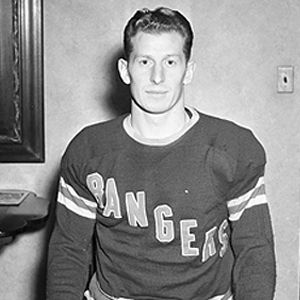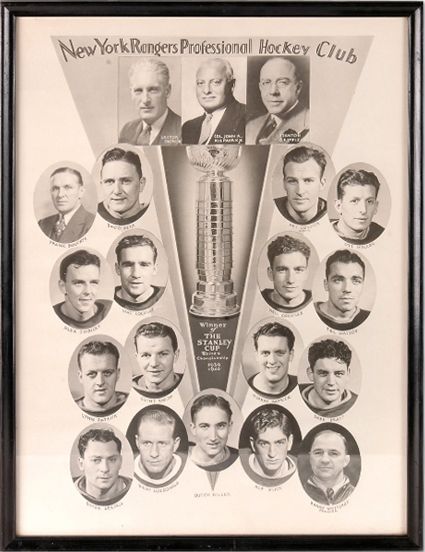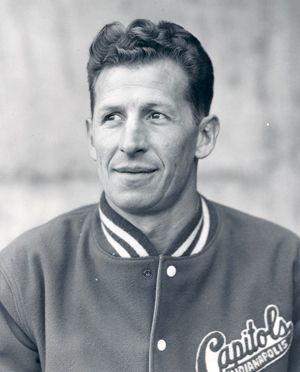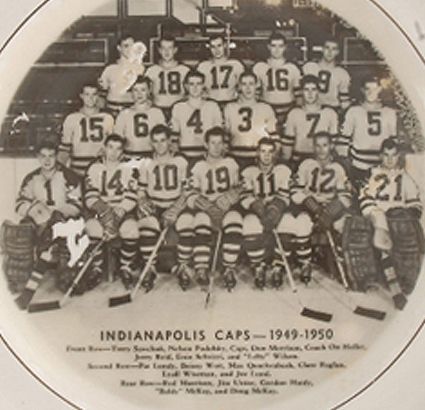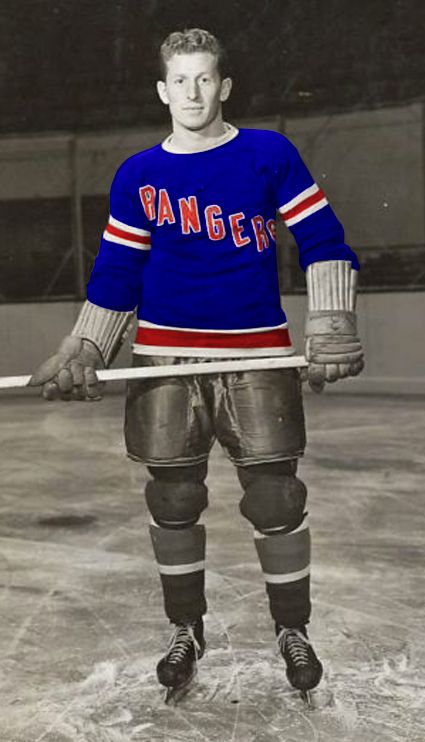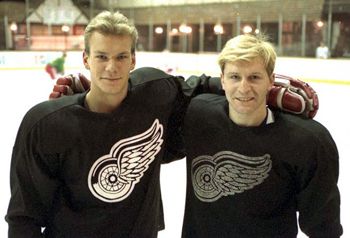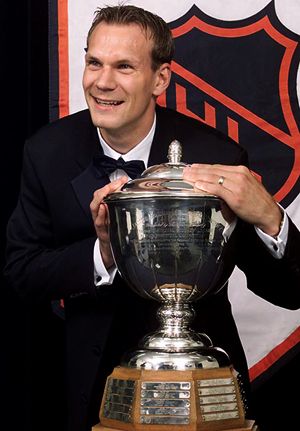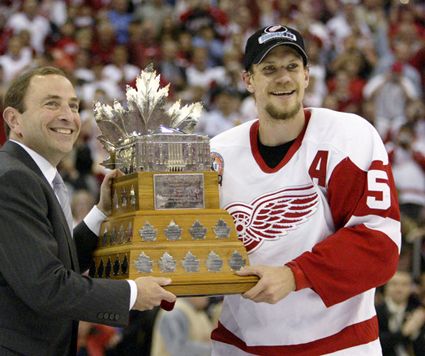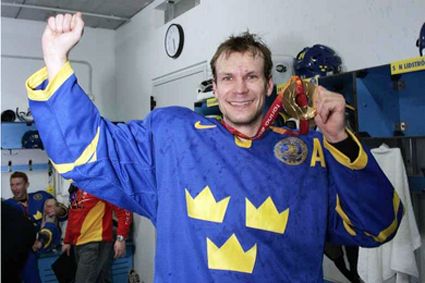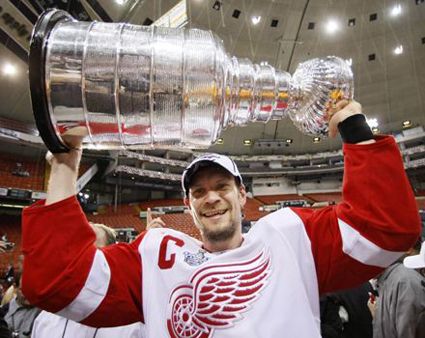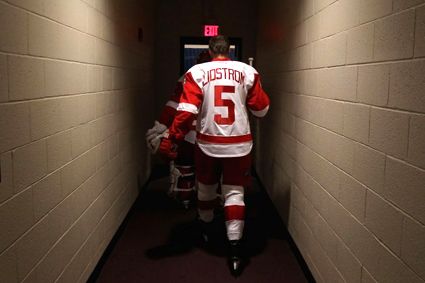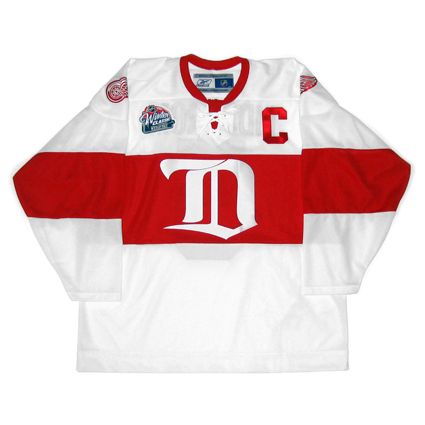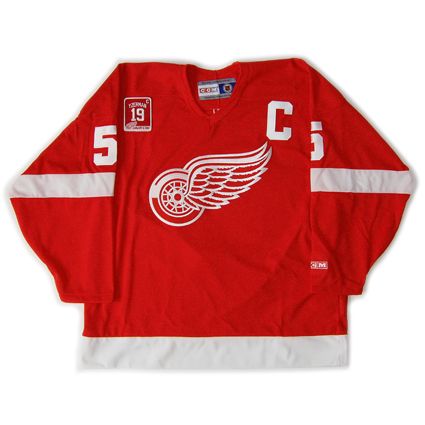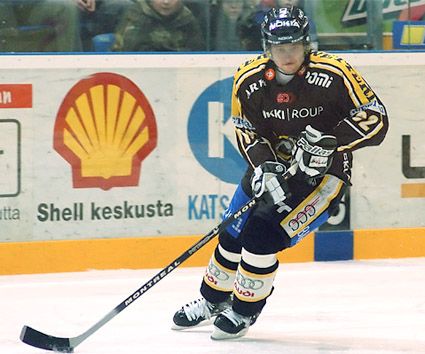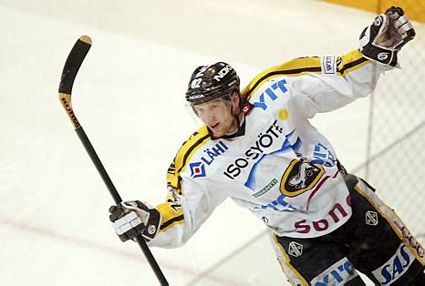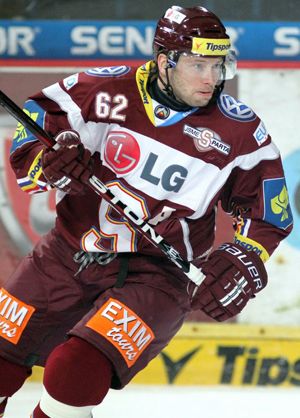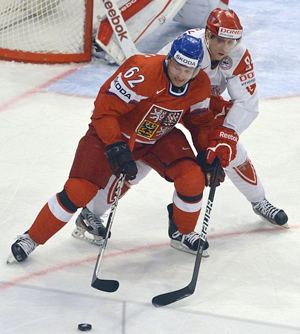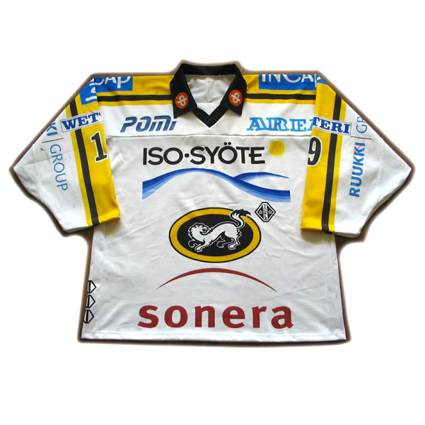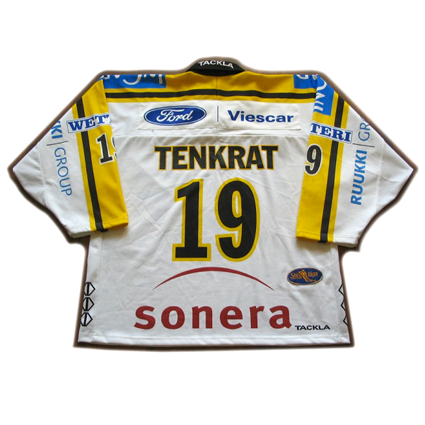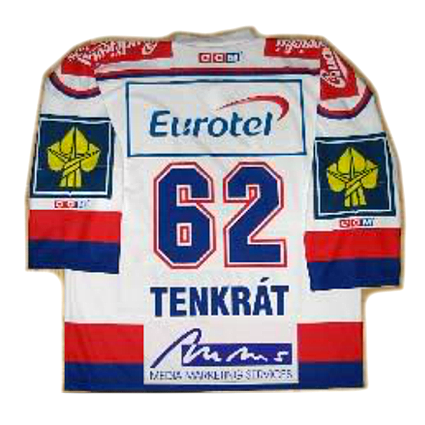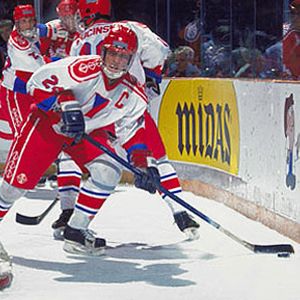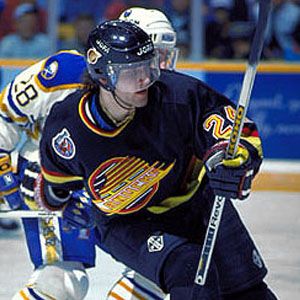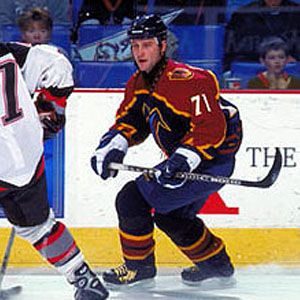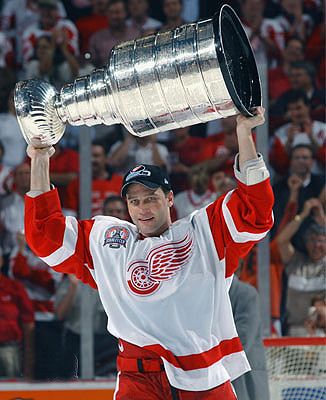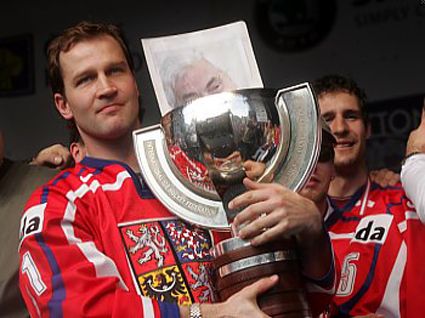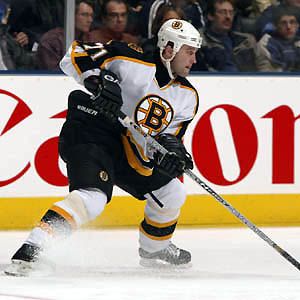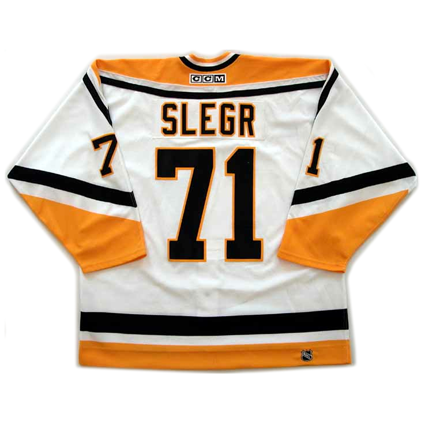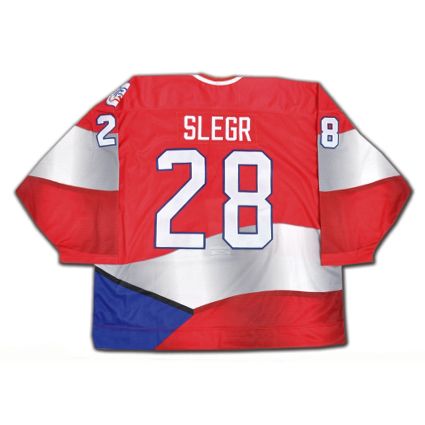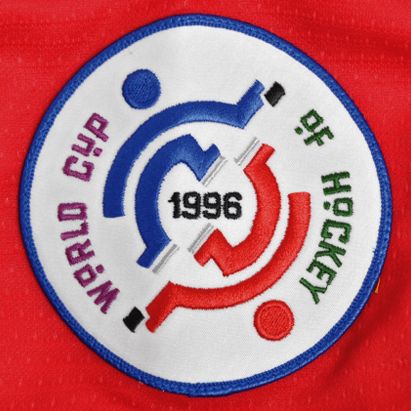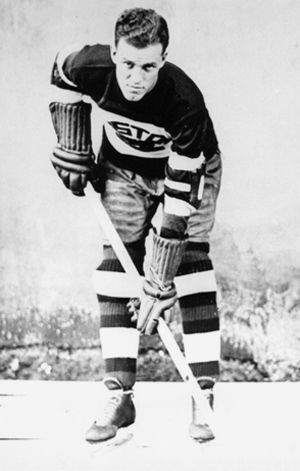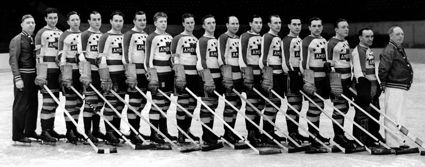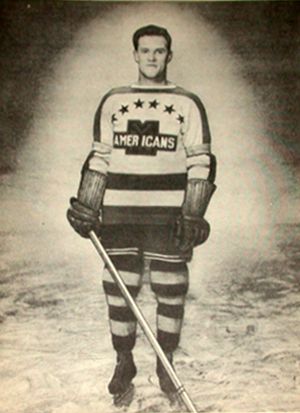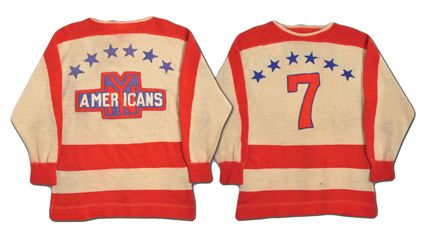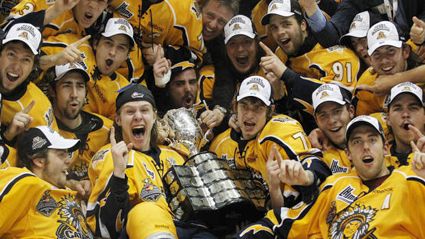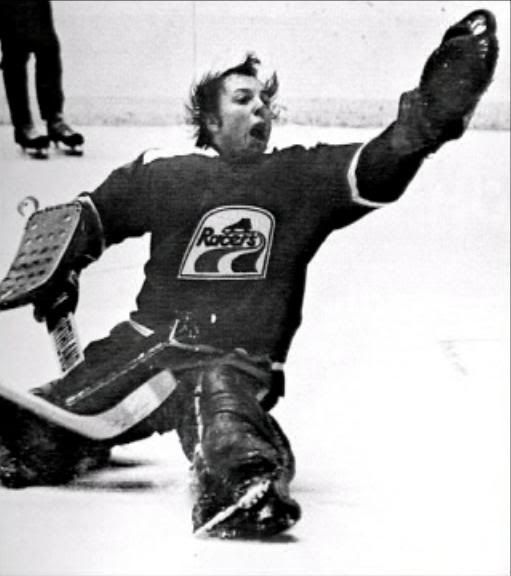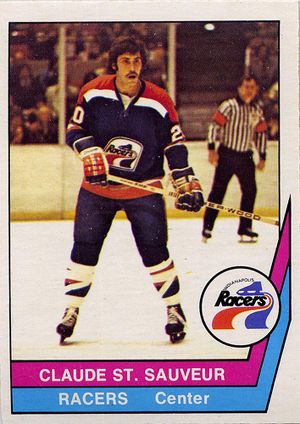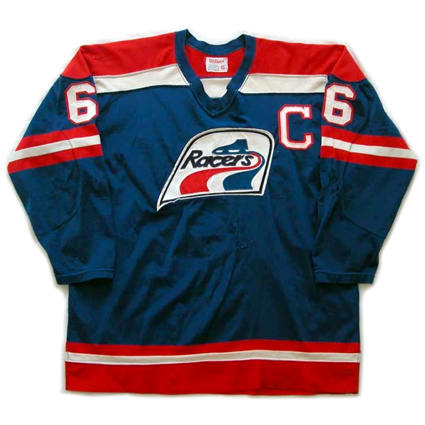Saturday, June 2, 2012
1939-40 New York Rangers Ott Heller Jersey
After playing two seasons with the Springfield Indians in the Canadian-American Hockey League, Ott Heller, born on this date in 1910, became a member of the New York Rangers in the 1931-32 season, when he split his time between the Rangers and Indians, playing 21 games with each club.
Heller, a defenseman, played full time for the Rangers in 1932-33, a season which concluded with New York winning its second Stanley Cup as Heller contributed 3 goals in 8 games after scoring 5 in 40 regular season games.
His career would come to be known for his skating ability, strong defensive play and his durability, as he would play nine seasons of 40 games or more from 1932-33 through 1940-41, with a high in points of 23, all assists, in 1938-39.
The following season would see the Rangers capture the Stanley Cup once again, as Heller's longevity would make him the only member of both the 1933 and 1940 championships teams.
The 1939-40 Stanley Cup champion New York Rangers
In 1942-43, he was named captain of the Rangers, just the third one in team history. The next season Heller would set an NHL career best in points with 35, 12 more than in 1938-39, his only other season with 20 points.
During his 15th season with the Rangers, rarely ever missing a game, Heller was sent down to the St. Paul Saints of the USHL as New York was on it's way to it's fourth consecutive last place finish, necessitating a youth movement.
Despite no longer being in the NHL, Heller's career was by no means finished, as he would continue playing ten more seasons, starting in the American Hockey League in 1946-47 with the New Haven Ramblers, where he scored a career high 36 points.
After a second season with the Ramblers, he found a home with the Indianapolis Capitols for four seasons as a player/coach.
Heller would guide the Capitols to win the Calder Cup in 1950 before returning to New Haven, only thing time with the New Haven Nutmegs of the Eastern Amateur Hockey League in the final season of the team and league.
The Calder Cup winning 1949-50 Indianapolis Capitols
He played senior hockey with his hometown Kitchener Dutchmen in 1952-53 and lend his services to the Cleveland Barons for the AHL playoffs. Still not ready to hang up his skates, he played for the Marion Barons of the International Hockey League in 1953-54.
His carer would finally wind down with 18 games with the Valleyfield Braves and 6 games back with the Cleveland Barons in 1954-55 and 7 games of senior hockey with the Chatham Maroons in the Ontario Hockey Association in 1955-56 at 45 years of age.
Today's featured jersey is a 1939-40 New York Rangers Ott Heller jersey. The Rangers would introduce their diagonally lettered sweaters right off the bat in 1926-27 for their first season, changing the lettering from white to red in 1927 and adding the white outlines in 1928. The sweaters would then remain unchanged through the 1940-41 season, after which today's familiar serifed font would be introduced.
Labels:
Heller Ott,
New York Rangers
Friday, June 1, 2012
2008-09 Detroit Red Wings Nicklas Lidström Jersey
One of the best defensemen in NHL history, Nicklas Lidström announced his retirement yesterday after a 20 year NHL career. Lidström had a brief hockey resume when he was drafted by the Detroit Red Wings in 1989, having only played one season for Västerås IK in Sweden and in one European Junior Championship.
Lidström was the 19th defenseman taken during that draft when he was selected 53rd overall. In fact, he wasn't even the first defenseman taken by the Red Wings, who had previously selected Bob Boughner 32nd overall with their second pick.
Bonus jersey: Today's bonus jersey is a 2006-07 Detroit Red Wings Nicklas Lidström jersey as worn on January 2, 2007, when the Red Wings honored their previous captain Steve Yzerman, by retiring his #19, an event commemorated on the player's jerseys with a special patch.
He would remain in Sweden for two more seasons, which included appearing in a World Junior Championship, a second European Junior Championship, making his senior international debut at the 1991 World Championships, where he won a gold medal, and in the 1991 Canada Cup before joining the Red Wings in 1991-92, impressing with 60 points as a rookie.
Lidstrom in the Red Wings Turn Back the Clock jersey
worn during his rookie season
After three seasons with the Red Wings, Lidström would return to the World Championships in the spring of 1994. Later that year he would play 13 games for Västerås while waiting for the NHL season to begin due to it's labor issues which delayed the start of the season until January of 1995. Back with the improving Red Wings, Lidström and his teammates were gaining more playoff experience each season, making the finals for the first time in 1995 and making it back to the conference finals in 1996.
Lidström was again chosen to represent Sweden in the 1996 World Cup of Hockey prior to the start of the 1996-97 NHL season, which would conclude with the Lidström winning the first Stanley Cup of his career.
For the 1997-98 season, Lidström was made an assistant captain for the Red Wings. Motivated by the accident in which teammate Vladimir Konstantinov was seriously injured, Detroit repeated as Stanley Cup champions again in 1998 as Lidström contributed 19 points in 22 games. Also during the 1997-98 season, Lidström would make his Olympic debut, as the NHL would suspend it's season, allowing it's best players to compete for the first time.
Lidstrom posing with Konstantinov in happier times
After three more seasons with Detroit, Lidström would be named the winner of the Norris Trophy for the first time in 2001, the first European so named.
The following season of 2001-02 would be a memorable one for Lidström, as he would win his second consecutive Norris Trophy, compete in his second Olympic Games, and win not only his third Stanley Cup, but become the first European to win the Conn Smythe Trophy in the process, as he chipped in 16 points in 23 games.
After two more seasons of play with Detroit, which included winning his third consecutive Norris Trophy, the first since Bobby Orr to win three in a row, Lidström would appear in his 1,000th NHL game, having missed only 17 games in 12 1/2 seasons. After the Red Wings were ousted from the playoffs, he would make an appearance in his first World Championship since 1994. Later that fall he would skate in his second World Cup of Hockey, the final hockey he would play for over a year, as the NHL season would be cancelled due to the lockout. While many players returned to Europe to compete, Lidström, now 34 years old, chose to take the season off.
His decision recharged his batteries, as when NHL play resumed in 2005-06, Lidström set a career high with 80 points, topping his previous best of 73 in 2000, and earning him his fourth Norris Trophy. He would also set a more dubious career high with 50 penalty minutes, thanks to a change in rules enforcement coming out of the lockout. During that season he would join a prestigious few, as he would score 6 points in 8 games as Sweden would capture the gold medal at the 2006 Olympics as Lidström scored the game winning goal in the final, making him a member of the Triple Gold Club, for winners of the World Championships, Stanley Cup and Olympics, one of only 18 men to have competed the trio of championships at the time.
He became the first European in franchise history to be named team captain in 2006-07 and would later be named the winner of the Norris Trophy once again. The 2007-08 season was another great season for Lidström, as he would reach 70 points for only the fourth time in his career, win his third consecutive and sixth Norris Trophy before the Red Wings would bring home the fourth Stanley Cup of Lidström's career in the span of 11 years, the first European born and trained player to captain any team to the Stanley Cup.
In 2009-10, Lidström became only the fourth Red Wing and eighth defenseman in NHL history to score 1,000 points. He would also compete in his fourth Olympics that season and was named team captain for Sweden.
Lidström would finish 2010-11 with a negative plus/minus rating (-2) for the first and only time in his career, but such was the respect for his ability to control a game and always make the ideal play, that he was recognized with his seventh Norris Trophy, the oldest player to ever win one, equalling the great Doug Harvey and pulling to within one of Orr's record of eight. Also that season, he scored the first hat trick of his now 19 year career at the age of 40, the oldest player to ever score a hat trick for the first time.
He would play one final season in 2011-12, after which Detroit would qualify for the playoffs for the 20th consecutive time in Lidström's career, which allowed him to finish second in NHL history in games played in the postseason with 263, just 6 back of former teammate Chris Chelios.
His final career totals are 1,564 games played, the most ever by a Red Wing or a European, 264 goals and 878 assists for 1,142 points, second all-time among Swedish-born players. Keeping in mind Lidström was a defenseman whose career high was 80 points, it's a testament to his longevity and incredible durability, as he never played less than 70 games a season and suited up 80 or more times 14 times. In all, he missed only 40 possible games in his 20 year career.
Today's featured jersey is a 2008-09 Detroit Red Wings Nicklas Lidström jersey as worn during the 2009 NHL Winter Classic. This jersey was based on the style first worn by the Detroit franchise back in 1926-27 when the club was original known as the Cougars, so named since their roster of players came from the now defunct Victoria Cougars of the old Pacific Coast Hockey League.
Today's video section begins with a news report about Lidström announcing his retirement.
Next, Lidström scores the game winning goal against Finland in the 2010 Winter Olympics.
Finally, an excellent highlight package from his entire 20 year NHL career.
Labels:
Detroit Red Wings,
Lidstrom Nicklas
Thursday, May 31, 2012
2003-04 Kärpät Oulu Petr Tenkrát Jersey
Today's story is one of globe-trekking international travel and collecting as many stamps in one's passport as humanly possible, for on this date in 1977, Petr Tenkrát was born in Kladno, Czechoslovakia.
His career began innocently enough, giving no clue as to what was to follow, as Tenkrát began playing for his hometown HC Kladno in 1994-95 with a single game. The right winger increased his games played to 20 in 1995-96 and 43 in 1996-97, which included his first goals as a professional. By the time Tenkrát began his professional career, Czechoslovakia had split into the Czech Republic and Slovakia, with Tenkrát making his international debut with the Czech Republic in the 1997 World Junior Championship, collecting his first passport stamp as the tournament was held in Switzerland.
He would play two additional seasons with Kladno, with his final one in 1998-99 seeing his offensive production leap up from 9 goals and 19 points to 21 goals and 35 points in 50 games. His potential was recognized by being selected by the Mighty Ducks of Anaheim in the 1999 NHL Entry Draft.
While he remained in Europe for the 1999-00 season, the first steps of his trek began in earnest as he moved from the Czech Extraliga to the Finnish SM-Liiga, joining HPK Hämeenlinna, scoring 20 goals and 29 points in 32 games. He remained in Finland for the 1999-00 season, only this time with Ilves Tampere.
He crossed the Atlantic for the first time in 2000-01, splitting time between the Cincinnati Mighty Ducks of the AL and the Mighty Ducks of Anaheim in the NHL. He had an unsettled 2001-02 season, playing for both Anaheim and Cincinnati before being traded to the Nashville Predators, with whom he would play 58 games, as well as an additional 4 with their top AHL affiliate, the Milwaukee Admirals.
It was back across the Atlantic for the 2002-03 season, joining Kärpät Oulu in Finland, where he fit right in, setting a career high with 40 points in 51 games. Kärpät would make it to the SM-Liiga finals, coming away with a silver medal.
His passport gained another stamp, as Tenkrát would begin the season with Khimik Voskresensk of the Russian Super League, where he would play 19 games before returning to Kärpät for the remainder of the 2003-04 season, impressively setting a career high with 22 goals in just 35 games. Kärpät would go on to win the league championship later that season and go back-to-back with a second title in 2005.
He would play one additional season in Oulu, averaging 37 points over his four seasons with Kärpät. Following the Finnish playoffs, he would return to the Czech Republic National Team for the 2006 World Championships in Latvia, where he earned a silver medal.
He next returned to the United States to join the Boston Bruins, who had acquired his NHL rights while he was in Finland. Typical of his NHL career, Tenkrát spent some time in the AHL, 7 games with the Providence Bruins, but the vast majority of 54 games was with Boston. It was back across the Atlantic once again to play in the 2007 World Championships in Moscow.
For the start of the 2007-08 season it was back to Kladno for 13 games before signing with Timrå IK in Sweden. 2008-09 was a repeat, playing for both Kladno and Timrå.
The pattern continued in 2009-10 with Kladno again, but his Swedish destination was Skellefteå AIK.
For the fourth season in a row, he played in two different countries, this time with Skellefteå in Sweden (9 games) and Kärpät in Finland for 45 games. For 2011-12, his nomadic career returned back to the Czech Republic in fine style, as he set career highs with 23 goals and 48 points with HC Sparta Prague in his 18th season of play.
He capped off his season with a bronze medal at the 2012 World Championships, held on familiar ground in both Sweden and Finland for what we calculate to be his 22nd border crossing among 7 countries to date, while generating a litany of game worn jerseys in his wake.
Today's featured jersey is a 2003-04 Kärpät Oulu Petr Tenkrát jersey as worn during Tenkrát's return to Kärpät, which translates to a stoat or an ermine, following his tenure with Khimik in Russia.
This jersey is typical of a Scandinavian jersey with it's many sponsorship logos, 14 in all not counting the Tackla branding, with the addition of the unique to Scandinavia collar on the jersey, which conveniently affords more surface are for yet more ads!
Bonus jersey: Today's bonus jersey is a 2005 Czech Republic National Team Petr Tenkrát jersey as worn in the annual Karjala Cup Tournament held in Finland. The tournament is part of a larger competition known as the Euro Hockey Tour, a series of small tournaments held in each of the participating nations, the Czech Republic, Finland, Russia and Sweden, and is an opportunity to prepare for the World Championship and Olympics, while often giving younger players a chance at gaining experience at the international level. The game results of the four tournaments are complied into a standings in order to declare a winner of the tour.
While the various national teams compete in the Olympics with jerseys which are sponsor-free, and the World Championships, with their distinctive single ads on the top of the arms, the national team jerseys in the Euro Hockey Tour are covered with many sponsorship logos seldom seen by North Americans.
Today's video segment is Tenkrát scoring on a beautiful one-timer for Kärpät followed by an impressive goal celebration.
This next video is Tenkrát scoring against Ryan Miller of the Buffalo Sabres while a member of the Bruins.
Labels:
Karpat Oulu,
Tenkrat Petr
Wednesday, May 30, 2012
2000-01 Pittsburgh Penguins Jiří Šlégr Jersey
Defenseman Jiří Šlégr, born on this date in 1971 began his career with CHZ Litvinov in 1987-88 and eventually played five seasons with the club before coming to North America to play in 1991-92 in the wake of the fall of Communism across Europe, which gave players the freedom to leave for the first time.
Prior to coming to the NHL, Šlégr had played for Czechoslovakia on five occasions, including the European Junior Championships in 1989, winning bronze medals at the World Junior Championships in both 1990 and 1991, which would prove to be a busy year for the young Šlégr, as he would also play in the 1991 World Championships as well as the 1991 Canada Cup. During his final Czechoslovak domestic season, Šlégr would also make his Olympic debut in his final appearance for Czechoslovakia in the 1992 Olympics in Albertville, France where he earned a bronze medal.
Šlégr joined the Vancouver Canucks organization, who had selected him with the second pick of the second round of the 1990 NHL Draft. His first season saw him divide his time between the Hamilton Canucks of the AHL (21 games) and make his NHL debut with Vancouver, playing in 41 games, scoring an impressive 26 points in exactly half a season of play while posting a +16 rating. He would also get his first taste of the NHL playoffs, seeing action in 5 games.
Given more important minutes based on his successful rookie season, Šlégr set a career high with 38 points from 5 goals and 33 assists in 78 games.
He would spend the early part of the 1994-95 season back with Litvinov, in what was by now the Czech Republic, due to the labor stoppage delaying the start of the NHL season until January. Once the NHL resumed, play, Šlégr would play 19 games with the Canucks before being traded in early April to the Edmonton Oilers.
He was limited to 57 games with the Oilers in 1995-96 and went on to make his debut for the Czech Republic at the 1996 World Cup of Hockey prior to the start of the 1996-97 season, which Šlégr spent back in Europe, appearing in one game with Litvinov, but primarily with Sodertalje SK in Sweden. He also played for the Czech Republic at the 1997 World Championships in the spring, earning another bronze medal.
In August of that year, Šlégr was traded to the Pittsburgh Penguins, with whom he spent the next four seasons, including setting an NHL career best 11 goals in 1999-00.
During his first season with the Penguins, the NHL would take a break from it's schedule to allow players to compete in the 1998 Olympics in Nagano, Japan, which Šlégr and his Czech teammates would take full advantage of, winning the gold medal in unexpected fashion. He was back on the international scene once again, earning another bronze at the 1998 World Championships.
Half way through the 2000-01 season, Šlégr was sent by the Penguins to the Atlanta Thrashers, where he would play 33 games to end the season.
He was with the Thrasher for 38 more games in the first half of the 2001-02 season before another trade, which sent him to the Detroit Red Wings. While he would only play 8 regular season games and 1 playoff game with Detroit, the Red Wings would go on to capture the Stanley Cup at the conclusion of the playoffs.
2002-03 was a lost season for Šlégr, as he would only play 10 games for Litvinov in the Czech Republic and 6 regular season and 9 playoff games for Avangard Omsk in the Russian Super League.
He returned to the NHL by signing a free agent contract with the Vancouver Canucks for 2003-04, but would end up spending the majority of his season with the Boston Bruins following a trade in January.
Following the season, Šlégr would return to the World Championships for the first time in six years. His second World Cup of Hockey came in September of that year. With the NHL season cancelled due to a lockout, Šlégr once again returned to where it began, suiting up for a full season with HC Litvinov, with whom he had his best offensive season in five years with 29 points.
With the Czech domestic season now over, Šlégr joined the national team for his fourth World Championshps for the Czech Republic, which they won with an 8-1 overall record, which included shutting out Canada 3-0 in the final, earning Šlégr a World Championship gold to go with his Olympic gold in 1998 and his Stanley Cup in 2002, making him a member of the prestigious Triple Gold Club, one of only 16 men at the time to have done so, and to date one of only two Czechs to have earned the honor, along with Jaromir Jagr.
Šlégr with the World Championship trophy,
which completed his membership in the Triple Gold Club
When the NHL resumed play in 2005-06, Šlégr was back with the Bruins, for whom he played 32 games.
Following that season, he returned to Litvinov for the sixth time! He would play four seasons there, retiring from hockey in 2010 before beginning his second career in politics, having been elected to Chamber of Deputies.
Šlégr with HC Litvinov
Šlégr's final NHL career totals are 622 games, 56 goals and 193 assists for 249 points.
Today's featured jersey is a 2000-01 Pittsburgh Penguins Jiří Šlégr jersey as worn during one of the Penguins opening pair of games in Japan against the Nashville Predators to open the NHL season. This was the third and final time the NHL season would get under way in Tokyo.
This style Penguins jersey was introduced in 1992-93 following their second Stanley Cup championship. The modernized Penguins logo was dubbed the "robo-Penguin" and remained in use through the 2001-02 season before a full-time return of the original skating penguin logo.
Bonus jersey: Today's bonus jersey is a 1996 Czech Republic Jiří Šlégr jersey as worn the first time Šlégr played for the Czech Republic following the breakup of Czechoslovakia in 1993.
This jersey was made by Bauer, and as such, the Czechs wore the larger 4" World Cup patch on the shoulder. Sweden and Canada also wore Bauer jerseys paired with the larger version of the patch, unlike the Nike teams, which wore the smaller 3" version of the tournament patch.
In today's video segment, Šlégr scores against Canada in the 1998 Olympics, much to the delight of the announcer.
Labels:
Pittsburgh Penguins,
Slegr Jiri
Tuesday, May 29, 2012
1935-36 New York Americans Art Chapman Jersey
Canadian Art Chapman, born on this date in 1906, played senior hockey in his hometown of Winnipeg, Manitoba for both the Winnipeg Tigers and Winnipeg Falcons in the mid 1920's before joining the Port Arthur Ports for the 1925-26 season. Chapman, a forward, scored 13 goals in 19 games during the regular season and added 3 more in 9 playoff games as the Ports won the Allan Cup as senior champions of Canada.
Chapman had an second productive season with Port Arthur (later Thunder Bay, Ontario) scoring 19 goals in 20 games before joining the Springfield Indians of the Canadian-American Hockey League in 1927-28. After one season with Springfield, he joined the Providence Reds of the same league, equalling his 14 goals from the previous year in 1928-29 before uncorking a career high 26 goals and 45 points in 1929-30, which allowed him to lead the Reds for a second consecutive season.
That performance led to Chapman getting his chance to play in the NHL, as he was selected by the Boston Bruins for the 1930-31 season in the 1929 Inter-League Draft. He would play four seasons for the Bruins, totaling 23 goals over that time span, with a high of 11 goals and 25 points in 1931-32.
In January of 1934 Chapman was traded to the New York Americans, where he would play for seven seasons.
In 1934-35, his first full season with New York, he would set an NHL career best with 43 points to lead the club in scoring. In 1935-36, he would score 10 goals, his only NHL season with double-digit goals, as he was better known for being responsible defensively.
He would then play in the NHL All-Star Game in the 1937 edition. His final season with the Americans came in 1939-40 before his career was interrupted by World War II.
He returned to playing hockey in 1942-43 with the Buffalo Bisons, where in 45 games he showed he still had plenty of skills, picking up where he left off with 9 goals and 28 points. He would retire after playing one final game with the Bisons in 1943-44.
He would later go into coaching hockey, winning a Calder Cup as head coach of Buffalo in 1944 and a Lester Patrick Cup with the Vancouver Canucks of the WHL in 1958.
Today's featured jersey is a 1935-36 New York Americans Art Chapman jersey. This sweater was worn during Chapman's highest scoring season in the NHL, his first full season with the Americans.
The Americans joined the NHL in 1925, one year before the New York Rangers, and wore their distinctive star spangled, multi-striped solely from 1925 through 1932-33 before finally introducing a white sweater for the 1933-34 season. After two seasons of use the sweater was modified when the single, blue waist stripe was changed to a pair of red stripes, a new wordmark crest was added and a series of arched stars was added to both the front and the back of the jerseys.
For the fourth season of use in 1938-39, the star-spangled jerseys were retired and the white sweater was now used full time, although with much thinner waist stripes, beginning a series of one year design tweaks as the club played out the string, ending in 1941-42 when they folded for good.
Photos courtesy of Classic Auctions
Labels:
Chapman Art,
New York Americans
Monday, May 28, 2012
2012 Memorial Cup Update
The Shawinigan Cataractes won their first Memorial Cup last night after a 43 year wait in a thrilling game which went deep into an overtime period before Anton Zobin converted Michael Bournival's centering pass from behind the goal line at 17:51 of the extra period to give Shawinigan a 2-1 victory, which caused an eruption of the 5,000 fans in attendance at their 4,100 seat arena.
Michael Chaput was voted the tournament MVP after scoring 12 points in 6 games for the Cataractes. Gabriel Girard made 34 saves for the winners.
Shawinigan had finished last in the round robin part of the tournament and needed to win a tie breaker to advance to the semifinals, where they defeated the defending champion Saint John Sea Dogs before winning in the final over the London Knights, their fourth game in five days, while London had five days rest after winning the round robin.
Labels:
2012 Memorial Cup
Sunday, May 27, 2012
1976-77 Indianapolis Racers Rosaire Paiement Jersey
With today being the 96th running of the Indianapolis 500, we thought it would be an appropriate day to take a look at history of the Indianapolis Racers of the WHA.
Indianapolis went without a team for nine years following the demise of the Indianapolis Capitals of the Central Hockey League, who only played nine games of their inaugural season before a gas explosion during an ice show killed 74 people and heavily damaged their home, the Indiana State Fair Coliseum, causing their parent club, again the Detroit Red Wings, to move the franchise to Cincinnati for the remainder of the season.
Indianapolis went without hockey until the arrival of the first major league team in the city's history in the form of the Indianapolis Racers of the World Hockey Association in 1974-75. The Racers, the first team to embrace the racing heritage of the city, played their games in the brand new 16,000 seat Market Square Arena.
The Racers had quite a rough start, winning only 18 while losing 57 with 3 ties their first season to finish dead last in the then 14 team WHA. They were led in scoring by Bob Whitlock's 31 goals and 57 points. Their goaltending duo was the maskless Andy Brown (52 games) and Ed Dyck (32).
Andy Brown, the last goalie to play without a mask
They bounced back nicely in year two, now coached by eventual Stanley Cup winner Jacques Demers, winning their division, although with a sub-.500 record at 35-39-6. They had a balanced scoring group, with veteran Pat Stapleton's 45 points leading six players with 40 points or more. Rookie Michel Dion and Brown shared the bulk of the work in goal, with Dion's 14 wins leading the club and his 2.74 goals against average being the best in the league, which was recognized with the award as the league's best goaltender. In the playoffs, they drew the New England Whalers and fell behind 3 games to 1. They fought back to force a Game 7 only to fall absolutely flat in a 6-0 loss at home to end their season.
The WHA was down to 12 teams for 1976-77 and the Racers finished third in the Eastern Division with a 36-37-8 record and were led in scoring with 71 points by Darryl Maggs, who had joined the team the previous season when the Denver Spurs folded in the middle of the season. The Racers won their first playoff series with a sweep of the Cincinnati Stingers, outscoring them by a clear 19-9. Their reward was a matchup with the Quebec Nordiques, who were led by the league's leading scorer Real Cloutier (141 points) and 100 point scorers Marc Tardif (109)and Chris Bordeleau (107). The Nordiques proved too much for the Racers, eliminating Indianapolis in five games.
With new head coach Ron Ingram behind the bench, the wheels came off for the Racers. The league had shrunk to just eight teams and the Racers finished dead last with a 24-51-5 record, 20 points back of Cincinnati, the only other team to miss the playoffs. Newcomer Claude St. Sauveur was the scoring leader with 36 goals and 78 points, well ahead of the rest of the club while Gary Inness' 52 games were by far the most in goal, but resulted in just 14 wins.
Desperately trying to survive, owner Nelson Skalbania signed the then 17-year-old Wayne Gretzky to play for the Racers for the 1978-79 season, which saw the league start the season with just seven clubs. The arrangement would only last eight games before Skalbania sold Gretzky to Peter Pocklington who owned the Edmonton Oilers.
Wayne Gretzky during his time with the Racers
In addition to Gretzky, Mark Messier had a five game cameo with the Racers that same season, but gave little indication of the success they would share together as he was held pointless.
It was a death blow for the Racers, who lasted just 15 more games before folding after just 25 games and a dismal 5-18-2 record when Skalbania was informed that Indianapolis would not be included in any NHL expansion plans and pulled the plug on December 15, 1978 without the Racers ever posting a winning record in their four plus seasons.
Today's featured jersey is a 1977-78 Indianapolis Racers Rosaire Paiement jersey from the first Indianapolis team to embrace the heritage of the Indianapolis 500 in their identity package.
The Racers wore the same jerseys for each of their five seasons, the last two changing from two color names to one color names on the back and this jersey has the distinction of being Wayne Gretzky's first professional jersey.
Paiement came to the Racers in 1976-77, having previously played for the Whalers and Chicago Cougars in the WHA after leaving the NHL, where he had spent time with the Vancouver Canucks and Philadelphia Flyers. After his second season with Indianapolis in 1977-78, he retired from play after 645 combined games.
Today's video section begins with highlights of the Indianapolis Racers from 1974 to 1979.
Perhaps the most significant moment in Indianapolis hockey history, Wayne Gretzky's first professional goal as a member of the Racers.
Labels:
Indianapolis Racers
Subscribe to:
Comments (Atom)

